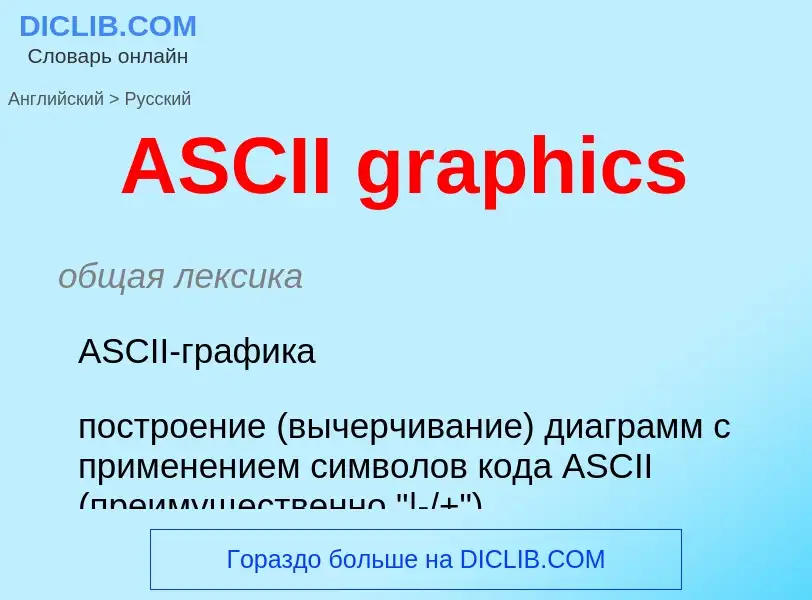Übersetzung und Analyse von Wörtern durch künstliche Intelligenz ChatGPT
Auf dieser Seite erhalten Sie eine detaillierte Analyse eines Wortes oder einer Phrase mithilfe der besten heute verfügbaren Technologie der künstlichen Intelligenz:
- wie das Wort verwendet wird
- Häufigkeit der Nutzung
- es wird häufiger in mündlicher oder schriftlicher Rede verwendet
- Wortübersetzungsoptionen
- Anwendungsbeispiele (mehrere Phrasen mit Übersetzung)
- Etymologie
ASCII graphics - Übersetzung nach Englisch
общая лексика
ASCII-графика
построение (вычерчивание) диаграмм с применением символов кода ASCII (преимущественно "|-/+")
синоним
Смотрите также
Американский стандартный код (для) обмена информацией
Wikipedia

ASCII art is a graphic design technique that uses computers for presentation and consists of pictures pieced together from the 95 printable (from a total of 128) characters defined by the ASCII Standard from 1963 and ASCII compliant character sets with proprietary extended characters (beyond the 128 characters of standard 7-bit ASCII). The term is also loosely used to refer to text-based visual art in general. ASCII art can be created with any text editor, and is often used with free-form languages. Most examples of ASCII art require a fixed-width font (non-proportional fonts, as on a traditional typewriter) such as Courier for presentation.
Among the oldest known examples of ASCII art are the creations by computer-art pioneer Kenneth Knowlton from around 1966, who was working for Bell Labs at the time. "Studies in Perception I" by Knowlton and Leon Harmon from 1966 shows some examples of their early ASCII art.
ASCII art was invented, in large part, because early printers often lacked graphics ability and thus, characters were used in place of graphic marks. Also, to mark divisions between different print jobs from different users, bulk printers often used ASCII art to print large banner pages, making the division easier to spot so that the results could be more easily separated by a computer operator or clerk. ASCII art was also used in early e-mail when images could not be embedded.





![A portion of the [[Brooklyn Daily Eagle]], 6 January 1875, showing advertisements made from typewriter art. A portion of the [[Brooklyn Daily Eagle]], 6 January 1875, showing advertisements made from typewriter art.](https://commons.wikimedia.org/wiki/Special:FilePath/Brooklyn-Daily-Eagle-1875-01-06.png?width=200)
![[[Dag Hammarskjöld]], printout from [[teleprinter]] 1961-62 [[Dag Hammarskjöld]], printout from [[teleprinter]] 1961-62](https://commons.wikimedia.org/wiki/Special:FilePath/Dag Hammarskjöld - ASCII - teleprinter art -1962.jpg?width=200)
![Sirius]]" from a 9th-century astronomical manuscript Sirius]]" from a 9th-century astronomical manuscript](https://commons.wikimedia.org/wiki/Special:FilePath/Illustration of the constellation Sirius - Harley Aratus (c.820-840), f.8v - BL Harley MS 647.jpg?width=200)




![Neofetch on [[Arch Linux]] Neofetch on [[Arch Linux]]](https://commons.wikimedia.org/wiki/Special:FilePath/Arch Linux Base Neofetch output.png?width=200)
![On [[MacOS Mojave]] On [[MacOS Mojave]]](https://commons.wikimedia.org/wiki/Special:FilePath/Neofetch.png?width=200)


